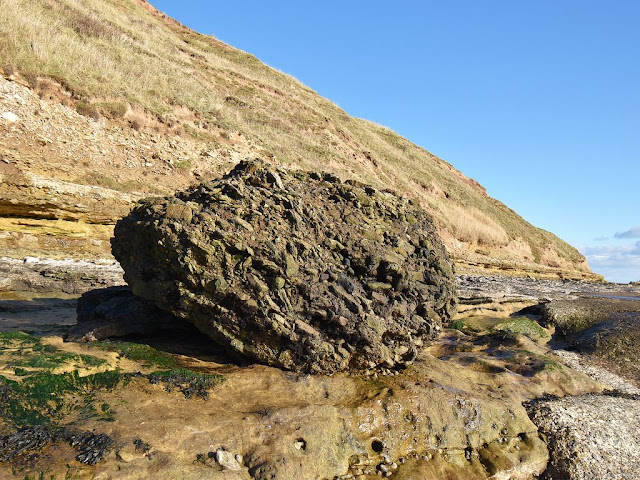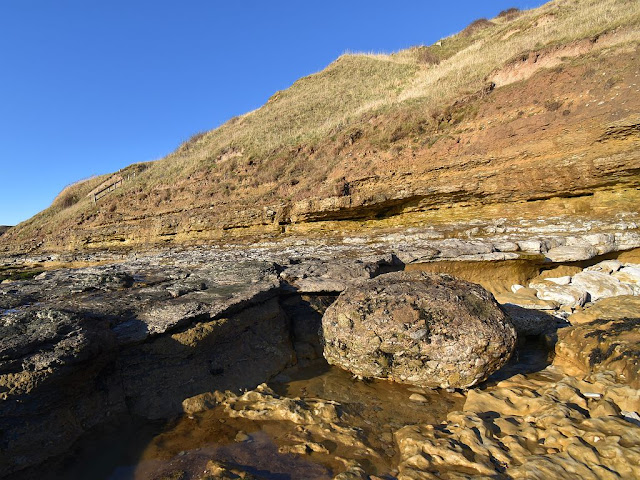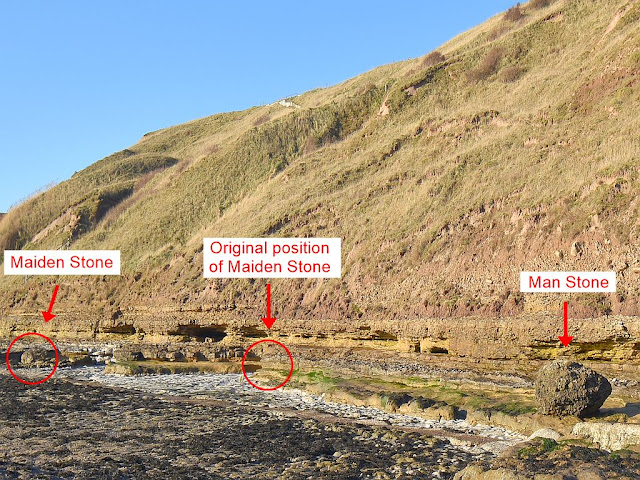Filey Brigg is a long and narrow headland extending out into the North Sea at Filey on the Yorkshire east coast.
The headland is almost one mile in length, and forms the north side of
Filey Bay. It is comprised of a ridge of high cliffs, which then drop down to
a bed rock platform pushing further out into the sea. This rocky projection is
the actual 'Brigg' (or Bridge), and a local legend records that it was built
by the Devil using his large hammer to pave the way. Where the bridge was
going is not recorded, but the Devil seems to have given up when he lost his
hammer in the sea.
The cliff top area is called Carr Naze or Nase - from the Norse word 'Ness', meaning a headland or promontory. Below the cliffs on the south side of the Naze, the old OS maps mark two boulders called the 'Man and Maiden Stones', however this appears to be the only reference to them. The rocks do not seem to be mentioned in local history books, so how they came to be named, or any folklore connected with them, has probably been lost.

|
|
Man and Maiden Stones on OS map (1854) (Image credit NLS) |
The stones are not marked on the modern OS maps, which might
suggest that they no longer exist - having being exposed to the North Sea
storms and tides for at least 150 years. However, a walk along the shore line
in January 2024 did find a large isolated boulder at the map grid reference
for the Man Stone, but there was no obvious sign of the Maiden stone, which
should have been located 25m further to the west. A closer look at the
Man stone found it to be a Breccia type rock composed of smaller stones and
pebbles naturally cemented together, and unlike the sandstone bedrock that it
sits on.

|
|
The Man Stone - Filey Brigg |
While checking the grid reference location for the Maiden Stone, a smaller boulder of the same Breccia rock as the Man Stone could be seen 25m further along the shore. This was the only other sizable boulder in this area, and being of the same rock type as the Man Stone makes it highly likely that this is the Maiden Stone. What has probably happened at some point in the past is that the smaller Maiden Stone was dislodged from its original position on the rock ledge by a storm or strong tides, and then rolled along the shoreline until it came to rest against a step in the bed rock.

|
| The Maiden Stone |
So it seems that originally this pair of Breccia boulders stood about 25m apart on the same rock shelf below the cliffs. These boulder stood out because of the unusual rock type, and also because they sat alone on this part of the shoreline, - some distance from the main spread of more regular shaped Sandstone blocks further along the Brigg. Standing out in this way seems to have led to the larger one being named the Man Stone, and the smaller one - the Maiden Stone. At one time there would have been a story to explain these names, but this seems to have been lost.
Although not mentioned by name, there does appear to be one reference to these boulders in The Filey Hand-book by Arthur Pettitt (1868), where he notes ...
"Near the foot of these steps are the celebrated wishing stones, one of which is very conspicuous ; if you can, with the little finger, remove one of the pebbles that look so easily to be pulled from out this great rounded lump of fallen cliff, you may wish what you will and your desire shall be gratified, provided you have due regard to various restrictions that have been made, and ceremonies introduced by different persons, which are, to say the, least, as reasonable as they are eflicacious."
The location and description in the above quote matches that of the Man and Maiden stones, and points to them being well known as Wishing stones at that time. While the 1868 guide book was for people visiting Filey, the inclusion of the Wishing stones as a point of local interest might suggest that there was some age to the tradition.
Folklore, customs and superstitions do seem to have continued in fishing communities longer than many other places. This is likely due to the dangers and uncertainties connected with sea fishing and living directly on the coast. These type of named wishing stones may have been part of the old beliefs and practices which it was hoped would keep people safe while out at sea, and provide the luck to bring home a good catch.
They roam where danger dwells,
Where blasts impetuous sweep,
Where sleep the dead in watery cells,
Beneath the faithless deep.
It is worth noting that further down the coast at Flamborough, two rock stacks were known as 'Adam and Eve', and another pair were called the 'king and Queen'. A single stack was also called the 'Matron', so there seems to have been a tradition of naming certain rocks on the shoreline in this way. Much further north there is another Maiden's Stone on the coast to the north of Berwick on Tweed.
After notes
The legend that the Devil built Filey Brigg with his hammer is reminiscent of
the giant Wade using his hammer to build Wade's Causeway on the North York
Moors. It is known that some old legends originally featured a giant character
who in later versions of the story was replaced by the Devil, so this may have
been the case at Filey Brigg. It has been said that 'The gods of the old
religion become the devil's of the new', and so the story of the Devil with his hammer may
well have its origins in the Scandinavian settlers on this
part of the coast, who brought with them their hammer wielding god Thor.
The cliff top area on Filey Brigg was also known as Cairn Head, so Carr Naze was probably Cairn Ness. This cairn was a mound half way along cliff top, which turned out to be the buried remains of a Roman signal station, and part of a chain of these stations along the east coast.
Reference
Arthur Pettitt (1868) The Filey Hand-book





Post a Comment